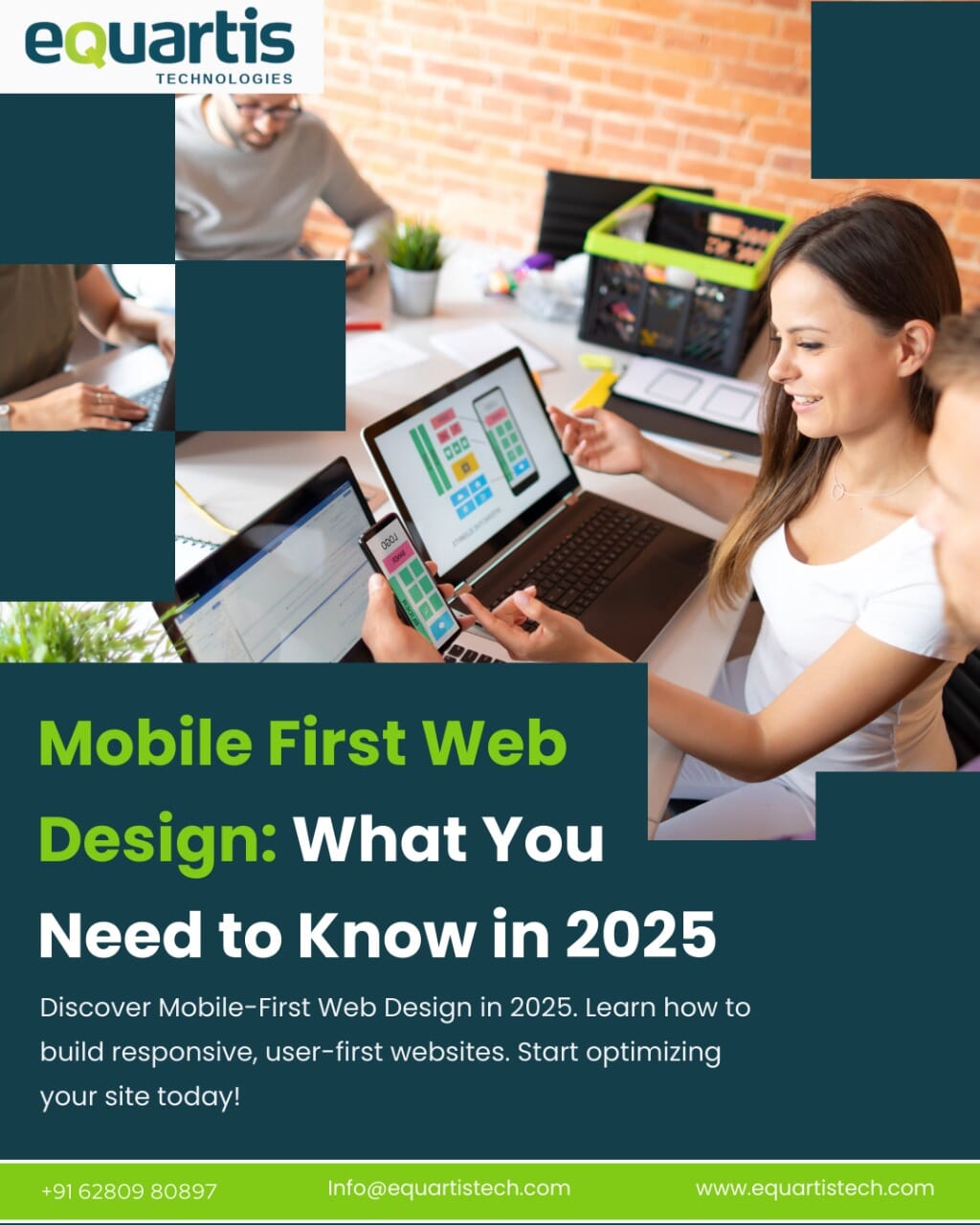
In 2025, the digital world continues to evolve rapidly, and so do user behaviors and expectations. More than ever, people are browsing, shopping, and consuming content through their smartphones. This shift makes one thing clear: optimizing for mobile is no longer optional. It’s essential. Enter Mobile-First Web Design — an approach that prioritizes mobile experiences before scaling up to desktop.
Whether you’re a business owner, developer, or designer, understanding this design philosophy is crucial for staying competitive. In this blog, we’ll explain what Mobile-First Web Design is, why it matters in 2025, and how to implement it effectively.
What is Mobile-First Web Design?
Mobile-First Web Design is a design strategy where the mobile version of a website is created before the desktop version. This method contrasts with traditional practices, where desktop designs were built first, and mobile versions were adapted later.
By starting with the limitations of smaller screens, such as less space, slower loading times, and limited user interaction, designers are forced to focus on core content and functionality. Once a solid mobile experience is achieved, additional features and visuals can be layered in for tablets and desktops.
Why Mobile-First Matters in 2025
1. Mobile Usage Continues to Grow
As of 2025, mobile devices account for over 70% of global web traffic. More people rely on their phones as their primary tool for internet access. Businesses that fail to prioritize mobile experiences risk losing a significant portion of their audience.
2. Search Engines Favor Mobile-First
Search engines like Google have officially adopted mobile-first indexing. This means that the mobile version of your website is considered the primary version for ranking and indexing. If your site doesn’t perform well on mobile, it will affect your search engine rankings.
3. User Expectations Are Higher Than Ever
Today’s users expect fast-loading, easy-to-navigate websites. Poor mobile performance leads to frustration and high bounce rates. With rising competition, offering a seamless mobile experience is no longer a luxury but a necessity.
Key Principles of Mobile-First Web Design
Designing with mobile as your starting point requires a strategic and user-centered approach. Here are the key principles that define mobile-first design:
1. Content Prioritization
When screen space is limited, it’s essential to focus on what’s most important. Mobile-first design forces you to streamline content and remove anything non-essential. The goal is to present only what the user truly needs.
2. Responsive Layouts
Using responsive web design techniques ensures that your layout adapts to various screen sizes. CSS media queries and flexible grids help create consistent experiences across devices.
3. Touch-Friendly Interfaces
Mobile users rely on tapping and swiping, so buttons and navigation elements must be easy to interact with. Avoid small clickable areas and ensure proper spacing between interactive elements.
4. Optimized Media
Images and videos should be optimized for mobile. This includes compressing file sizes, using appropriate formats, and leveraging lazy loading techniques to speed up page performance.
5. Performance Optimization
Fast-loading websites are critical. Mobile users often experience slower connections, so minimizing HTTP requests, optimizing code, and using content delivery networks (CDNs) can greatly enhance performance.
Designing a Mobile-First Experience: Step-by-Step
Step 1: Understand Your Users
Start by identifying who your users are and how they interact with your website. Use analytics tools to track mobile behaviors, screen sizes, bounce rates, and conversion paths.
Step 2: Sketch the Mobile Layout First
Create wireframes that reflect the mobile view. This ensures that key features and content are prioritized. From there, scale up your design to include tablets and desktops.
Step 3: Focus on Essential Features
Determine what users need most on the go — be it product details, booking forms, navigation, or contact information. Build the user journey around these critical actions.
Step 4: Test Across Devices
Don’t assume your design works just because it looks good on one phone. Test on multiple devices and screen sizes to ensure a consistent experience.
Step 5: Iterate Based on Feedback
Mobile-first design is an iterative process. Gather user feedback, monitor performance metrics, and make improvements continuously.
The Role of UI/UX in Mobile-First Design
UI/UX design plays a central role in mobile-first strategies. It focuses on creating interfaces that are not only visually appealing but also intuitive and user-friendly.
Key UI/UX Considerations:
- Visual hierarchy: Use typography, color, and spacing to guide users.
- Consistency: Keep UI elements consistent across pages.
- Accessibility: Ensure text is readable, buttons are reachable, and the interface is usable by people with disabilities.
- Feedback: Provide visual feedback (like button animations or form validations) to keep users informed.
Common Mistakes to Avoid
While mobile-first is a powerful strategy, certain pitfalls can reduce its effectiveness:
1. Overloading the Mobile Version
Avoid trying to cram everything from the desktop site into the mobile layout. Focus on essentials.
2. Ignoring Tablet Users
While mobile-first focuses on smartphones, don’t neglect tablets. Design should scale gracefully to all screen sizes.
3. Poor Navigation Design
Hamburger menus and hidden navigation need to be well-thought-out. Test how users interact with navigation on smaller screens.
4. Not Testing Performance
Mobile users often face connectivity issues. Regularly test site speed and load times on real devices and networks.
Tools and Technologies to Help You
Embracing Mobile-First Web Design requires the right set of tools:
1. Frameworks
- Bootstrap and Foundation: Offer responsive grid systems.
- Tailwind CSS: Utility-first framework for rapid UI development.
2. Design Tools
- Figma and Adobe XD: Great for creating mobile-first prototypes.
- Sketch: Popular for UI/UX design.
3. Testing Tools
- BrowserStack: Cross-browser and device testing.
- Google Mobile-Friendly Test: Check how well your site performs on mobile.
- Lighthouse: Analyze performance, accessibility, and best practices.
Mobile-First vs. Responsive Design: What’s the Difference?
Many people confuse mobile-first design with responsive design. While both aim to improve the user experience across devices, they have different starting points:
- Mobile-First Design: Starts with mobile and scales up.
- Responsive Design: Typically starts with desktop and adjusts to smaller screens.
A mobile first design ensures that essential content and features are prioritized, while a responsive design can sometimes result in complex and bloated mobile versions.
How Mobile-First Affects SEO and Conversions
Search engine optimization (SEO) and conversion rates are directly impacted by mobile design. Here’s how:
- Improved SEO: Google favors mobile-optimized sites. Mobile-first indexing means your ranking depends on your mobile site’s quality.
- Better User Engagement: Clean, fast, and intuitive mobile experiences reduce bounce rates and increase time on site.
- Higher Conversion Rates: Optimized checkout flows and simple interfaces can boost sales and sign-ups.
Final Thoughts and Future Outlook
As technology continues to evolve, mobile-first will likely become the default design strategy for most digital products. With the rise of wearable devices, voice search, and AI-driven personalization, designing for smaller screens will become even more critical.
Embracing Mobile-First Web Design in 2025 is essential for any brand or business aiming to stay relevant. It’s not just about aesthetics; it’s about delivering better user experiences, improving SEO, and increasing conversions.
And remember, for businesses looking to provide seamless experiences across both websites and mobile platforms, integrating a strong Mobile application Development strategy alongside mobile-first design can deliver even greater results.





